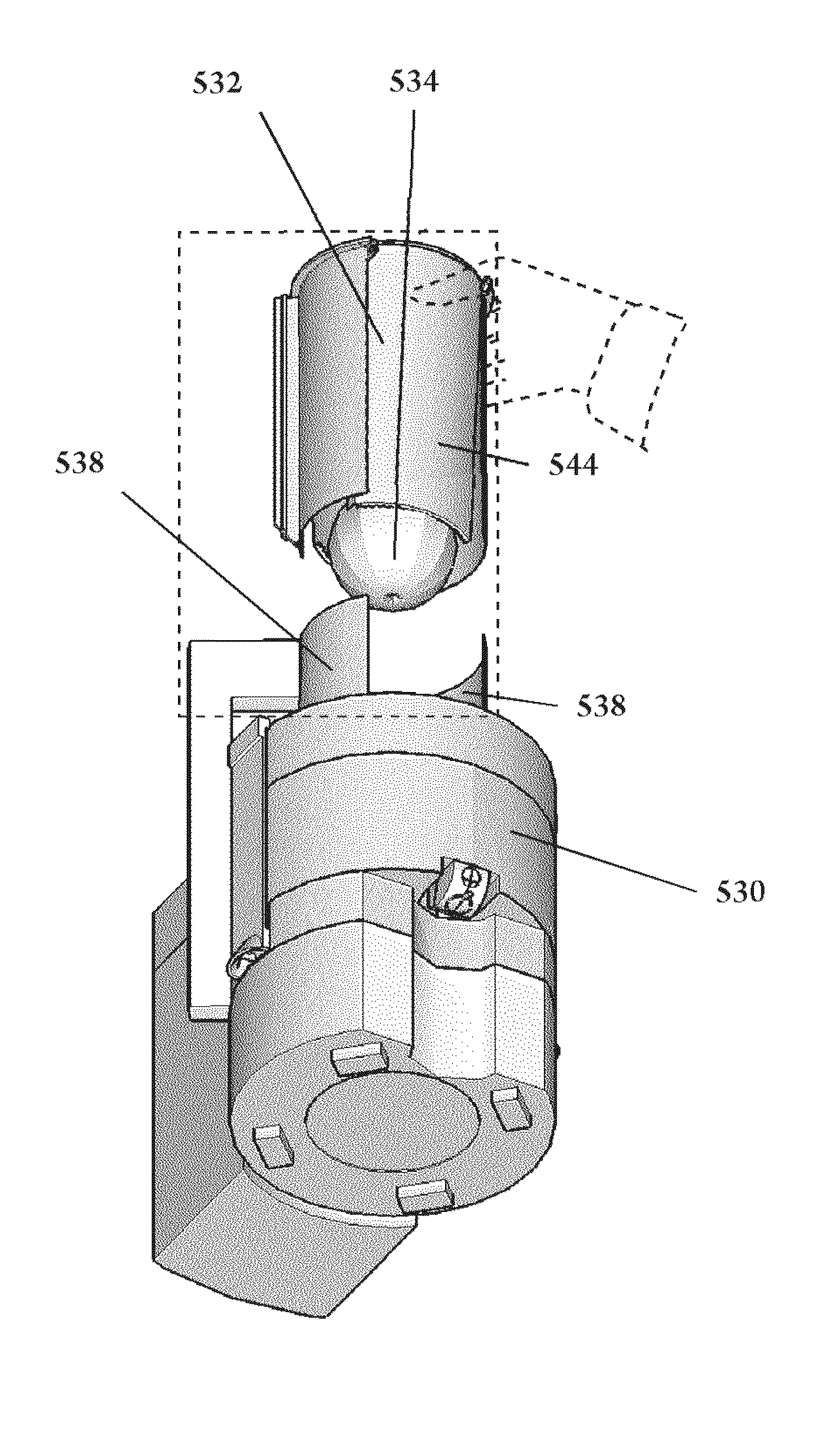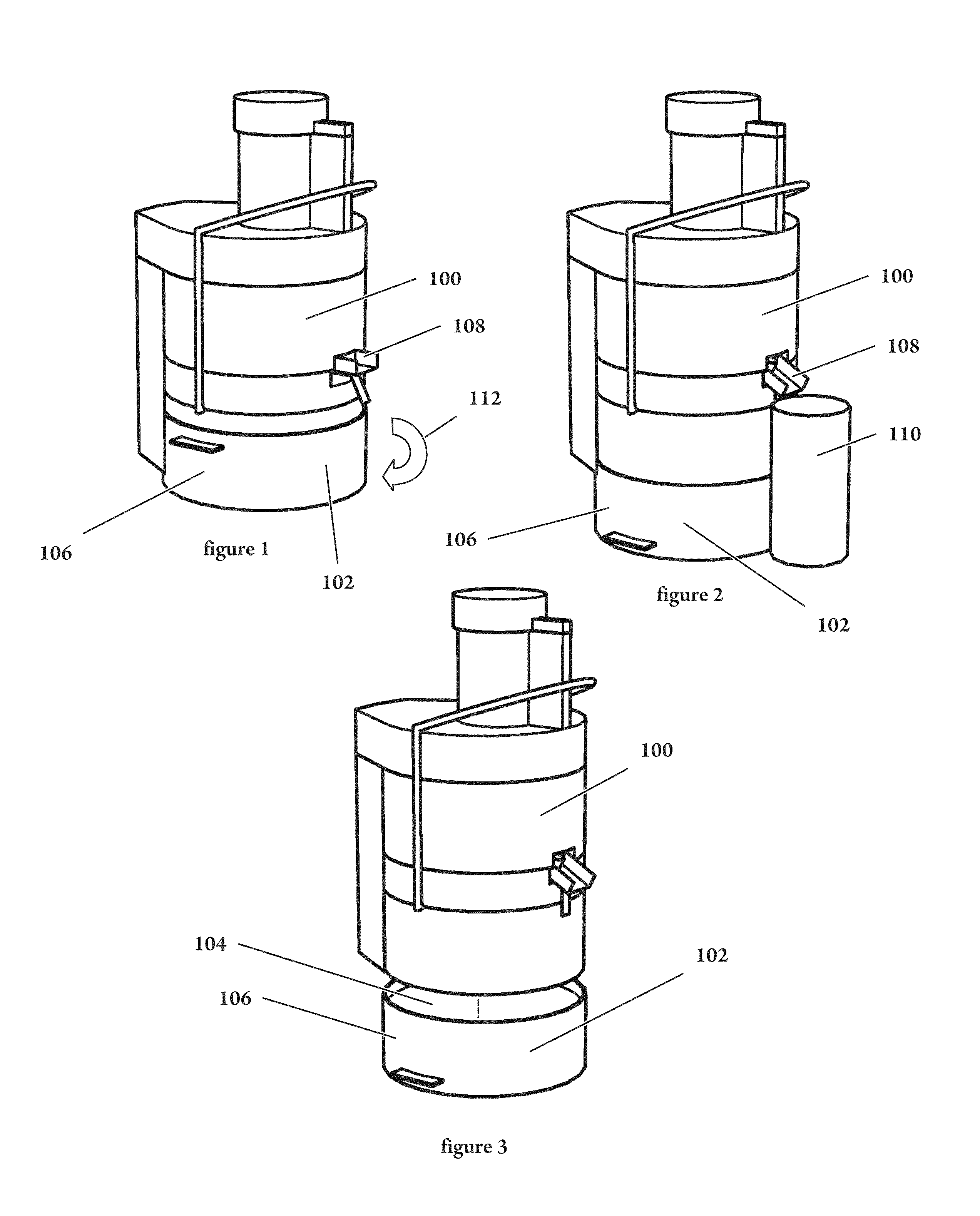Devices and methods to disintegrate foods
a technology of foods and devices, applied in the direction of grain treatment, manufacturing tools, centrifuges, etc., can solve the problems of reducing the efficiency of the process, affecting the safety of the same users, and difficult to clean
- Summary
- Abstract
- Description
- Claims
- Application Information
AI Technical Summary
Benefits of technology
Problems solved by technology
Method used
Image
Examples
embodiment one
Exemplary Preferred Embodiment One
[0167]Referring to FIGS. 1 through 3, food preparation device 100 is supported by base 102. Food preparation device 100 may be a centrifugal type juice extractor as illustrated, or it may be an alternative such as by way of a non-limiting examples, a food processor or blender or other type of food processing device. Base 102 has generally vertical sidewalls 106 at its periphery. Generally horizontal partition 104 is asymmetrically placed vertically within vertical sidewalls 106 and divides the space within vertical sidewalls 106 into 2 concavities, one being shallow and the other being deep and occupying most of the interior space defined by sidewalls 106. Generally horizontal partition 104 may be contiguous or may have openings penetrating some or most of its surface. Vertical sidewalls 106 are spaced wide enough apart to allow food preparation device 102 to telescope within vertical sidewalls 106.
[0168]FIG. 1 shows when food preparation device 100...
embodiment two
Exemplary Preferred Embodiment Two
[0171]FIGS. 4 through 6 illustrate adjustable height base 114 used to elevate and lower food preparation device 116. As shown in FIG. 6, base 114 includes helical slots 118 and 120 which penetrate through generally vertical sidewalls 122. At the top of helical slots 118 and 120 are two finger grips which mirror each other, and only one of which, finger grip 124, is shown. As is shown in FIG. 6 as well, food preparation device 116 also has finger grip 126, which has a counterpart which is replicated on the opposite side of food preparation device 116.
[0172]As shown in FIGS. 4 and 5, food preparation device 116 telescopes within adjustable height base 114. As also shown in FIGS. 4 and 5, finger grip 126 projects through helical slot 118, and, not shown, its opposite side counterpart projects through helical slot 120. When finger grip 126 is squeezed 127 toward finger grip 124, and their opposite side counterparts are simultaneously squeezed toward one...
embodiment three
Exemplary Preferred Embodiment Three
[0175]FIGS. 7 through 9, and including FIG. 9 enlargement 9A, show another preferred embodiment. Here, food preparation device 132 telescopes inside of, and raises and lowers vertically within, base 134 allowing taller liquid collecting receptacles, such as exemplary glass 136 to be placed below pour spout 138. Latch actuation button 140 is biased outward and rides within slot 142. This arrangement is imaged on the opposite side of base 134 and food preparation device 132 where a latch actuation button which is not shown rides within slot 144. Food preparation device 132 is raised within base 134 by finger pressure pulling latch actuation button 140 toward finger rest 146 and simultaneously doing the same action with the latch actuation button not shown and finger rest 148. Latch claws 150 grip detents on the interior of sidewalls 152 to hold food preparation device 132 in its raised position. Pressing in on latch actuation button 140 and the oppo...
PUM
 Login to View More
Login to View More Abstract
Description
Claims
Application Information
 Login to View More
Login to View More - R&D
- Intellectual Property
- Life Sciences
- Materials
- Tech Scout
- Unparalleled Data Quality
- Higher Quality Content
- 60% Fewer Hallucinations
Browse by: Latest US Patents, China's latest patents, Technical Efficacy Thesaurus, Application Domain, Technology Topic, Popular Technical Reports.
© 2025 PatSnap. All rights reserved.Legal|Privacy policy|Modern Slavery Act Transparency Statement|Sitemap|About US| Contact US: help@patsnap.com



